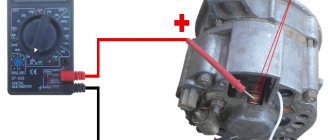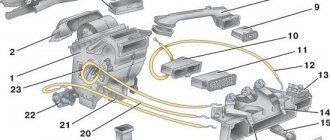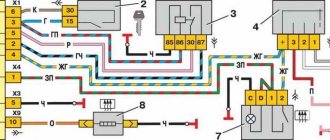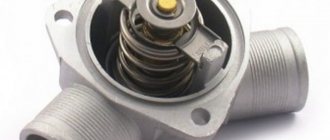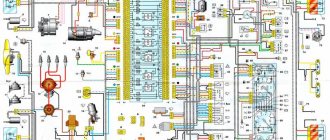The engine of a VAZ-2115 car operates in optimal mode only at a certain temperature. And if the cold does not have a critical effect on the power unit, then overheating, as a rule, leads to its damage and failure. A cooling system is designed to maintain optimal temperature conditions. The thermostat is its necessary component. The article will discuss the thermostat for the VAZ-2115, checking its performance and replacing the faulty element.
For reference. Since 2007, VAZ-2115 cars have been equipped with an injection 4-cylinder 8-valve engine. The power of the power unit is 80.9 hp, volume is 1596 cc.
How to check the thermostat
It is very easy to check the operation of the thermostat without removing it from the car. It is enough to start the cooled engine and check the temperature of the radiator pipes. In normal mode, when the engine is running, for some time after starting, only the upper radiator pipe will heat up slightly, and when the threshold value is reached, the lower pipe will also heat up sharply. This is evidence of normal valve operation. If heating of both radiator pipes begins simultaneously, this indicates that it is not functioning properly; most likely, the valve is constantly open.
The constantly open thermostat valve allows you to easily reach the nearest service station or spare parts store. It is much worse if the thermostat gets stuck closed, as there is a serious risk of engine overheating. Sometimes tapping on the thermostat body helps for a short time, but if the valve cannot budge, it should be removed or bent with a screwdriver. The thermostat must be replaced in the nearest locality.
Repair. Yes or no?
As a rule, when the thermostat fails, it immediately comes to replacing the element. But can it be repaired?
Homemade treatment method In principle, this can be done. But you don’t always have to count on results. This is because the repair consists of applying several medium blows to the body using a simple screwdriver. Sometimes this allows the valve to open. If this method does not help, you have no choice but to replace it.
Where is
It is located under the air filter housing on injection cars, but on carburetor Samara 2 (namely, the first VAZ 2115 were produced for a couple of years in a carburetor version), it is located exactly there, but the housing on them has simply been moved to a slightly different place, so it is no longer necessary on the carburetor It doesn’t take much trouble to remove the housing, but I just threw off the high-voltage wires and started working, but it doesn’t take long to remove the housing and on the injector it 100% needs to be removed to get to the thermostat, and after the housing is put aside, you will immediately see the thermostat is not armed it will even be visible to the eye (For clarity, it is indicated in the photo below with a red arrow) and next to it there is also a battery (indicated by a blue arrow) so that you understand 100% where it is and do not lose sight of it.
Necessary tools
- New thermostat.
- Open-end wrenches for 13 and 12.
- Phillips screwdriver (medium size).
- An empty container for draining the coolant (it is better if it is a basin with a capacity of at least 5 liters; it will fit under the car without any problems).
- Sealant.
- Using a 13 key, unscrew the air filter.
- Unscrew 2 bolts and 1 nut on the radiator. Under one of the bolts there is a hole through which the coolant is drained into a container placed in advance under the radiator. Drain bolt on the radiator for draining antifreeze.
- The connector located on the recirculation valve filter housing is removed. Then the valve itself is removed and carefully moved to the side along with all the tubes located next to it. The connector from the air flow sensor is also removed, the clamp on it is loosened, and then the air supply hose is removed. All hoses have been removed from the recirculation filter housing and the thermostat is ready for removal.
- After these operations, the filter is easily removed and access to the thermostat is opened.
- Use a 12 wrench to unscrew the nut on the top of the thermostat (there is only one there). After this, the ground wire is removed and the stud and the lower nut on the device are unscrewed with a 13mm wrench.
- After this, the thermostat is removed from the socket (this is done by slightly shaking the device, and if this does not help, the thermostat is pryed off with a screwdriver). The thermostat is carefully removed from the socket.
- Before installing a new thermostat, the socket is thoroughly wiped off from drops of coolant and other contaminants, after which a thin layer of sealant is applied (the sealant must be allowed to dry for at least 5 minutes before installing the device).
- The new thermostat is installed in its original place, after which all components of the vehicle’s cooling system are reassembled.
As you can see from this article, changing the thermostat is a task that even a novice car enthusiast can do. The main thing to remember when deciding to replace this device is that you cannot save money on it, since repairing engine damage caused by a faulty thermostat will cost the car owner much more.
The principle of operation of the VAZ 2115 thermostat
In a car's engine cooling system, a thermostat automatically opens and closes a large cooling circuit for antifreeze.
Let's try to explain this in a nutshell. The engine cooling system consists of a small and a large circuit.
In the engine warm-up mode, the antifreeze is driven by the system pump only through the engine cooling jacket and the heater. This allows you to quickly heat the cylinder block to operating temperature. But further on we can’t do without additional cooling.
When a certain temperature is reached, the thermostat opens a channel into a large circuit - the coolant enters the main radiator, equipped with an additional highly efficient electric fan operating at several speeds. By opening and closing the valve, the thermostat not only maintains the set antifreeze temperature, but also ensures the energy efficiency of the power plant.
Using the VAZ 2115 car as an example, I will now show how it works:
- When the car is not warmed up, the thermostat valve is closed, as in the photo. In this case, the coolant moves in a small circle, as in the photo below.
- When the machine warms up to operating temperature (87-90 degrees), the temperature-sensitive element slowly begins to heat up, as a result of which the spring compresses, the main valve opens and the liquid flows in a large circle.
Narrowing of the bypass channel
If you decide that it is the bypass channel on the VAZ 2110 that needs to be adjusted, then the 6-hole thermostat should not have any problems. But with a 5-hole one, malfunctions may occur due to the fact that the cold pipe of the stove (outlet) will not be washed. Therefore, think about whether you need such a modification; maybe it’s better to immediately install a Granta thermostat or a six-hole one.
To reduce the bypass, you need to do the following:
- Cut a plate out of sheet aluminum so that it fits exactly inside the vehicle;
- Secure the plate with a rivet or cold welding, but so that the fastening does not interfere with the flow of coolant in a small circle;
- In this plate you need to drill a new hole of 5 or 6 mm (instead of the standard 8 mm);
- In addition to the steps described above, on a 6-hole heater, the stove return is connected to a thermostat.
Standard bypass channel in the thermostat Aluminum plate to reduce the bypass channel Installed plate with a reduced bypass channel Self-tapping screws are made flush After this modification, you will notice that the interior will warm up better and faster, but warming up of the engine will slow down somewhat.
How to check the thermostat on a VAZ 2115 - two ways
In order to check the thermostat on a VAZ 2115, you must perform the following steps:
- Take a pan with cold water, a thermometer up to at least one hundred degrees and a thermostat.
- We put it all on the tile to warm up and wait... We wait until the water temperature reaches 85 degrees.
- At this point we begin to look at the main thermostat valve. At 87 degrees it should open.
- If it does not open or opened earlier, then the thermostat is faulty.
There is another way to check the thermostat without removing it from the car. But for this, the car must be cold:
- After starting the engine, grab the lower pipe coming from the radiator with your hands.
- Until the temperature reaches 80 degrees it should be completely cold. When it reaches 85 degrees, the tube should begin to warm up slowly.
- And when 90 degrees is reached, full circulation of hot coolant should begin (i.e. the valve is completely open). The lower tube should be hot.
It happens that immediately after starting the engine, when it has warmed up only 50 degrees, warm liquid begins to flow through the lower tube. This shouldn't happen either!!! This means that the valve is constantly open.
Cylinder block
The liquid coolant circulates in the engine block through a system of special channels - the cooling jacket. If a malfunction occurs, antifreeze may leak for the following reasons:
- insufficient tightening of the cylinder head bolts,
- head gasket failure,
- formation of metal microcracks.
If, after a long period of parking on a cold engine, coolant leaks are noticeable at the junction of the head and block, then most likely the cylinder head bolts are not tightened properly. To eliminate a leak, check the tightness of the bolts and, if necessary, tighten them to the required torque.
If the cylinder head gasket is damaged, the antifreeze goes inside the engine: either into the combustion chamber or into the crankcase. Coolant entering the combustion chamber causes unstable engine operation (up to the impossibility of starting) and thick milky-white smoke from the muffler.
In this case, in a well-warmed-up car at high speeds, there is a sharp increase in the amount of antifreeze in the expansion tank, until the expansion cap is knocked out.
If the coolant goes into the engine crankcase, it mixes with the oil. This fact can be diagnosed by the presence of a white emulsion coating on the oil filler cap and on the oil dipstick. A sharp darkening of fresh antifreeze is another symptom that the cooling system is in contact with oil. It is necessary to replace a broken or burnt cylinder head gasket.
The worst option is the appearance of microcracks: the symptoms are similar to the previous case, but it is problematic to eliminate this problem with your own hands. First of all, the crack may not be visible on the removed part, but it will certainly manifest itself when the bolts are tightened and on a warm engine. To eliminate microcracks, the head or block is polished using specialized equipment. In the worst case scenario, you will need to purchase a new cylinder head.
Car thermostat: how to check, typical faults, symptoms
The thermostat is a small but important element of the car, which allows the driver to save on engine maintenance and fuel. Essentially, the thermostat is a temperature regulator in the cooling system. Due to it, the engine warm-up speed increases, and the car maintains the desired thermal conditions during operation.
The main task facing the thermostat in a car is to prevent the circulation of coolant through a large cooling circle until the engine warms up after starting.
After starting the engine, the antifreeze begins to circulate in a small circle until it reaches an operating temperature of approximately 90 degrees Celsius. Having warmed up, the coolant enters a large circulation circle and circulates through it until it cools down again (due to various reasons).
Through its actions, the thermostat maintains the operating temperature in the engine, preventing it from overheating or excessively cooling.
Cooling system operation diagram
Cars of the Samara-2 family (VAZ 2113, 2114, 2115) are equipped with a closed-type cooling system with forced circulation of coolant. The system maintains excess antifreeze pressure, which creates an increased boiling point and allows the liquid to heat up to 110-115°C.
1 – expansion tank plug; 2 – extended
Antifreeze, located in the cooling jacket of the cylinder head and block, removes the heat generated during fuel combustion in the engine. Fluid circulation is ensured by a centrifugal-type water pump (pump), which is driven by a timing belt.
When the car moves, the antifreeze in the radiator is cooled by blowing with a flow of oncoming air and then returns through the pipes to the engine block.
The antifreeze temperature is monitored by a sensor in the thermostat housing, information from which goes to the instrument panel indicator and to the car's ECU. When the antifreeze heats up to a certain temperature (95°, 98°, 105° - depending on the settings of the control unit), the electric motor of the fan located on the inside of the radiator automatically turns on. Also, on front-wheel drive VAZs, antifreeze from the engine transfers heat to the heater radiator to heat the interior.
An expansion tank with an antifreeze level sensor is used to fill the system with liquid. The total capacity of the VAZ 2114 system depends on the modification and averages 7.8 liters.
Features of the VAZ-2115 thermostat and its operating principle
The thermostat is an essential element in a vehicle's cooling system. A new domestically produced part can withstand from 80,000 kilometers to 100,000 kilometers, and an imported one - about 120,000 kilometers. It is very important that the thermostat is of high quality, so it is necessary to purchase it for replacement in specialized auto stores.
A car thermostat controls the temperature of the coolant (for example, antifreeze), and distributes it among circulation circles - small and large. If the vehicle engine and cooling fluid are cold, the thermostat valve will be closed, allowing the small circulation circle to operate.
As soon as the optimal temperature regime of the cooling liquid is reached, the thermostatic valve will operate, that is, it will open and a large circulation circle will come into effect.
The flow of coolant will enter the radiator, and the temperature will stop increasing, and its level will stabilize - optimally 90 degrees. This is the principle of operation of the thermostat element in good condition.
Water pump
The pump on the VAZ 2114 (catalog number 2109-1307010) is installed in the lower part of the engine block under the timing belt tension roller. If you detect coolant leaks on the protection in the area of the right front wheel, you should remove the plastic timing belt cover and check the pump.
The water pump is attached to the block with three bolts. Often, due to exposure to high temperatures, the pump body “sticks” to the seat; in this case, in order to dismantle the pump, it should be carefully tapped. Before installing a new part, be sure to clean the contact area on the engine from remnants of the old gasket and sealant. Among car owners, water pumps from TZA (Tolyatti), LUZAR and a reliable, but more expensive option: HEPU are popular.
When does a thermostat need to be replaced?
For proper operation of a vehicle, it is important that the temperature of its engine is within the same limits. This can be achieved through the use of coolant - antifreeze or antifreeze - and the proper operation of the entire cooling system of the car. As soon as the temperature begins to exceed the required limits (most often it is 90 degrees), you should check the car thermostat for serviceability. If it turns out that this part is out of order, then there will be a need to replace it with a new one.
The best manufacturers
When choosing a thermostat, keep in mind that AvtoVAZ does not produce these devices, but purchases them from partner companies, so if you see that the packaging says “manufactured by AvtoVAZ JSC” and there is no indication of the real manufacturer, then this is a fake. It is very difficult to make an objective rating of thermostats for VAZ 2110 or any other cars, because the operation of this device depends on many factors, including the condition of the engine cooling system. However, according to reviews from owners of VAZ 2108–2115 cars, we have ranked the manufacturers as follows:
